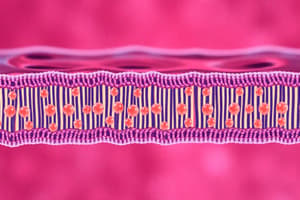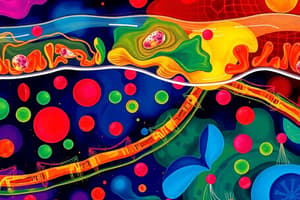Podcast
Questions and Answers
What property of water contributes most to its high surface tension?
What property of water contributes most to its high surface tension?
- Its non-polar nature causing repulsion between molecules.
- Its ability to dissolve a wide variety of solutes.
- Its polar nature and attraction to itself (cohesion). (correct)
- Its low density in solid form compared to liquid.
If a cell loses its ability to properly recognize other cells, which type of protein on the cell surface is most likely malfunctioning?
If a cell loses its ability to properly recognize other cells, which type of protein on the cell surface is most likely malfunctioning?
- Adhesion proteins
- Recognition glycoproteins (correct)
- Transport proteins
- Receptor proteins
In the cell membrane, which of the following accurately describes the behavior of hydrophobic molecules?
In the cell membrane, which of the following accurately describes the behavior of hydrophobic molecules?
- They dissolve easily in the aqueous environment inside the cell.
- They repel polar molecules. (correct)
- They attract polar molecules toward the membrane.
- They facilitate the transport of ions across the membrane.
A cell needs to transport a large, polar molecule across its membrane from an area of low concentration to high concentration. Which protein task would be required for this process?
A cell needs to transport a large, polar molecule across its membrane from an area of low concentration to high concentration. Which protein task would be required for this process?
A mutation causes a cell's integral membrane proteins to detach easily from the cell membrane. What part of the protein structure is most likely affected by this mutation?
A mutation causes a cell's integral membrane proteins to detach easily from the cell membrane. What part of the protein structure is most likely affected by this mutation?
Which of the following properties correctly describes a cell as an open system?
Which of the following properties correctly describes a cell as an open system?
If a scientist is studying how a hormone binds to a cell, which type of protein would they most likely be investigating?
If a scientist is studying how a hormone binds to a cell, which type of protein would they most likely be investigating?
What is the primary role of adhesion proteins in a cellular context?
What is the primary role of adhesion proteins in a cellular context?
What is the main function of the cytoskeleton attachment proteins?
What is the main function of the cytoskeleton attachment proteins?
Where are peripheral proteins typically located in relation to the cell membrane?
Where are peripheral proteins typically located in relation to the cell membrane?
How do cells use glycoproteins on their surface?
How do cells use glycoproteins on their surface?
What happens to hydrophilic molecules in the phospholipid bilayer?
What happens to hydrophilic molecules in the phospholipid bilayer?
In electron transport, what is the primary action facilitated by proteins in the cell membrane?
In electron transport, what is the primary action facilitated by proteins in the cell membrane?
What characteristic defines the region of the phospholipid bilayer as hydrophobic?
What characteristic defines the region of the phospholipid bilayer as hydrophobic?
Which of the following statements correctly describes integral proteins?
Which of the following statements correctly describes integral proteins?
Why is the phospholipid bilayer essential to the function of the cell as an open system?
Why is the phospholipid bilayer essential to the function of the cell as an open system?
How does the structure of the phospholipid bilayer contribute to its function as a barrier?
How does the structure of the phospholipid bilayer contribute to its function as a barrier?
What would happen if a cell’s membrane lost its adhesion proteins?
What would happen if a cell’s membrane lost its adhesion proteins?
If the cell membrane were impermeable to electrons, which protein task would be most affected?
If the cell membrane were impermeable to electrons, which protein task would be most affected?
How does a cell's ability to recognize other cells contribute to tissue formation?
How does a cell's ability to recognize other cells contribute to tissue formation?
Flashcards
What are open systems?
What are open systems?
Cells that allow energy and matter to enter and exit through the cell membrane.
What is a Phospholipid Bilayer?
What is a Phospholipid Bilayer?
A double layer of lipids with hydrophilic heads and hydrophobic tails, forming the basic structure of cell membranes.
What does hydrophilic mean?
What does hydrophilic mean?
Having an affinity for water; typically polar molecules that are attracted to water.
What does hydrophobic mean?
What does hydrophobic mean?
Signup and view all the flashcards
What are peripheral proteins?
What are peripheral proteins?
Signup and view all the flashcards
What are integral proteins?
What are integral proteins?
Signup and view all the flashcards
What are Transport proteins?
What are Transport proteins?
Signup and view all the flashcards
What are Receptor Proteins?
What are Receptor Proteins?
Signup and view all the flashcards
What are Adhesion proteins?
What are Adhesion proteins?
Signup and view all the flashcards
What are Cytoskeleton Attachment proteins?
What are Cytoskeleton Attachment proteins?
Signup and view all the flashcards
What are Electron Transport proteins?
What are Electron Transport proteins?
Signup and view all the flashcards
What are Recognition proteins?
What are Recognition proteins?
Signup and view all the flashcards
Study Notes
- Cells are open systems that allow energy and matter to move in and out through the cell membrane
Phospholipid Bilayer
- Water is a polar molecule that is attracted to itself due to cohesion, which results in high surface tension
- Hydrophilic molecules are polar, attracting other polar molecules toward the membrane
- Hydrophobic molecules are non-polar, repelling polar molecules
Proteins in Cell Membrane
- Peripheral proteins are located on the surface
- Integral proteins are embedded in the membrane
Protein Tasks
- Transport proteins move substances across the membrane
- Receptor proteins act as binding sites for hormones and neurotransmitters
- Adhesion proteins attach cells to other cells or organelles
- Cytoskeleton attachments anchor cells to the cytoskeleton
- Electron transport proteins move electrons between molecules
- Recognition proteins, such as glycoproteins on the cell surface, are used for identifying cells
Studying That Suits You
Use AI to generate personalized quizzes and flashcards to suit your learning preferences.




